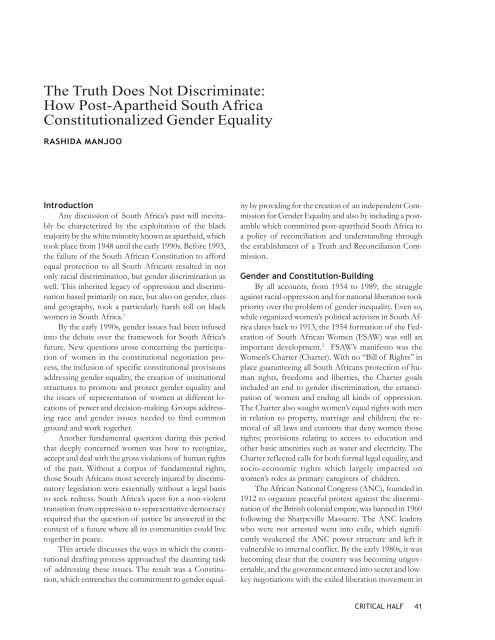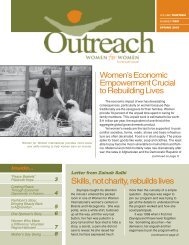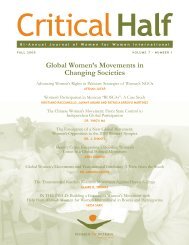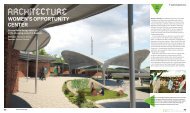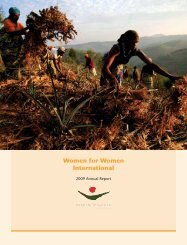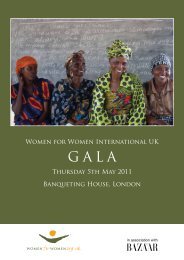Gender and Constitution Building - Women for Women International
Gender and Constitution Building - Women for Women International
Gender and Constitution Building - Women for Women International
You also want an ePaper? Increase the reach of your titles
YUMPU automatically turns print PDFs into web optimized ePapers that Google loves.
The Truth Does Not Discriminate:<br />
How Post-Apartheid South Africa<br />
<strong>Constitution</strong>alized <strong>Gender</strong> Equality<br />
RASHIDA MANJOO<br />
Introduction<br />
Any discussion of South Africa’s past will inevitably<br />
be characterized by the exploitation of the black<br />
majority by the white minority known as apartheid, which<br />
took place from 1948 until the early 1990s. Be<strong>for</strong>e 1993,<br />
the failure of the South African <strong>Constitution</strong> to af<strong>for</strong>d<br />
equal protection to all South Africans resulted in not<br />
only racial discrimination, but gender discrimination as<br />
well. This inherited legacy of oppression <strong>and</strong> discrimination<br />
based primarily on race, but also on gender, class<br />
<strong>and</strong> geography, took a particularly harsh toll on black<br />
women in South Africa. 1<br />
By the early 1990s, gender issues had been infused<br />
into the debate over the framework <strong>for</strong> South Africa’s<br />
future. New questions arose concerning the participation<br />
of women in the constitutional negotiation process,<br />
the inclusion of specific constitutional provisions<br />
addressing gender equality, the creation of institutional<br />
structures to promote <strong>and</strong> protect gender equality <strong>and</strong><br />
the issues of representation of women at different locations<br />
of power <strong>and</strong> decision-making. Groups addressing<br />
race <strong>and</strong> gender issues needed to find common<br />
ground <strong>and</strong> work together.<br />
Another fundamental question during this period<br />
that deeply concerned women was how to recognize,<br />
accept <strong>and</strong> deal with the gross violations of human rights<br />
of the past. Without a corpus of fundamental rights,<br />
those South Africans most severely injured by discriminatory<br />
legislation were essentially without a legal basis<br />
to seek redress. South Africa’s quest <strong>for</strong> a non-violent<br />
transition from oppression to representative democracy<br />
required that the question of justice be answered in the<br />
context of a future where all its communities could live<br />
together in peace.<br />
This article discusses the ways in which the constitutional<br />
drafting process approached the daunting task<br />
of addressing these issues. The result was a <strong>Constitution</strong>,<br />
which entrenches the commitment to gender equal-<br />
ity by providing <strong>for</strong> the creation of an independent Commission<br />
<strong>for</strong> <strong>Gender</strong> Equality <strong>and</strong> also by including a postamble<br />
which committed post-apartheid South Africa to<br />
a policy of reconciliation <strong>and</strong> underst<strong>and</strong>ing through<br />
the establishment of a Truth <strong>and</strong> Reconciliation Commission.<br />
<strong>Gender</strong> <strong>and</strong> <strong>Constitution</strong>-<strong>Building</strong><br />
By all accounts, from 1954 to 1989, the struggle<br />
against racial oppression <strong>and</strong> <strong>for</strong> national liberation took<br />
priority over the problem of gender inequality. Even so,<br />
while organized women’s political activism in South Africa<br />
dates back to 1913, the 1954 <strong>for</strong>mation of the Federation<br />
of South African <strong>Women</strong> (FSAW) was still an<br />
important development. 2 FSAW’s manifesto was the<br />
<strong>Women</strong>’s Charter (Charter). With no “Bill of Rights” in<br />
place guaranteeing all South Africans protection of human<br />
rights, freedoms <strong>and</strong> liberties, the Charter goals<br />
included an end to gender discrimination, the emancipation<br />
of women <strong>and</strong> ending all kinds of oppression.<br />
The Charter also sought women’s equal rights with men<br />
in relation to property, marriage <strong>and</strong> children; the removal<br />
of all laws <strong>and</strong> customs that deny women those<br />
rights; provisions relating to access to education <strong>and</strong><br />
other basic amenities such as water <strong>and</strong> electricity. The<br />
Charter reflected calls <strong>for</strong> both <strong>for</strong>mal legal equality, <strong>and</strong><br />
socio-economic rights which largely impacted on<br />
women’s roles as primary caregivers of children.<br />
The African National Congress (ANC), founded in<br />
1912 to organize peaceful protest against the discrimination<br />
of the British colonial empire, was banned in 1960<br />
following the Sharpeville Massacre. The ANC leaders<br />
who were not arrested went into exile, which significantly<br />
weakened the ANC power structure <strong>and</strong> left it<br />
vulnerable to internal conflict. By the early 1980s, it was<br />
becoming clear that the country was becoming ungovernable,<br />
<strong>and</strong> the government entered into secret <strong>and</strong> lowkey<br />
negotiations with the exiled liberation movement in<br />
CRITICAL HALF 41


